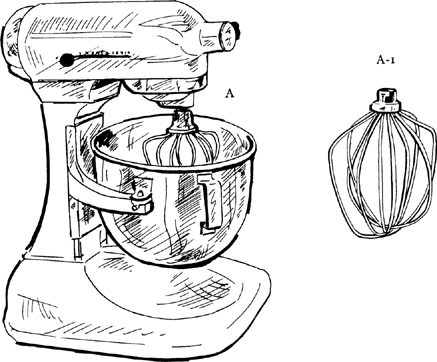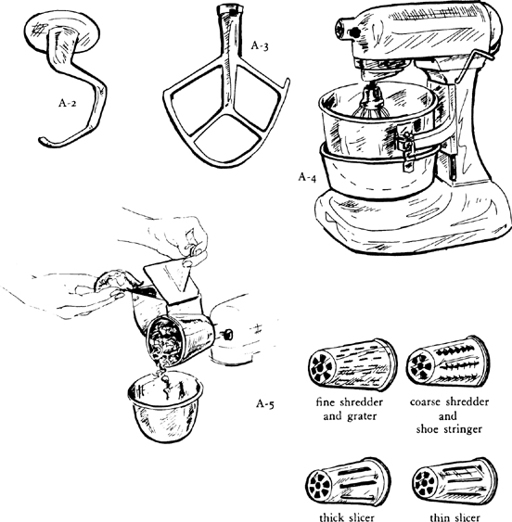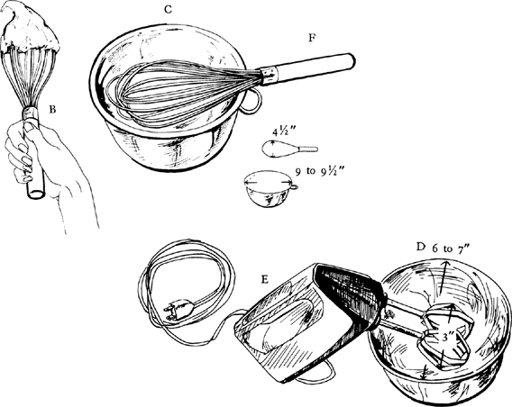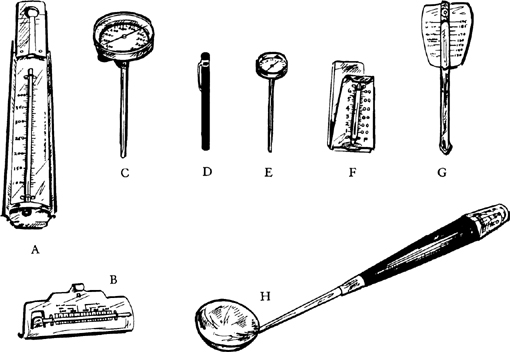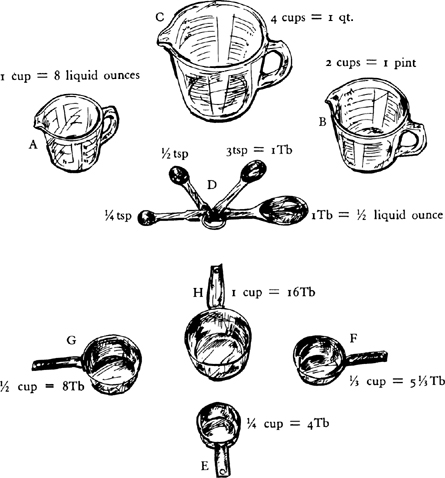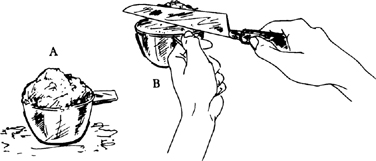Mastering the Art of French Cooking, Volume 2 (223 page)
Read Mastering the Art of French Cooking, Volume 2 Online
Authors: Julia Child

BEATING EGG WHITES
You are far more likely to welcome soufflés, meringues, cakes, and baked Alaskas—or even to encourage them—when you have the proper egg-white beating equipment. We urge you to consider the type of heavy-duty
electric mixer
illustrated here (A). Its large revolving whip (A-1) also rotates around the bowl, beating egg whites so easily it will never again occur to you to think of them as a problem. In fact, this is a replica of the large industrial machines designed by professionals for professionals; to have a home model available is a tremendous help to all of us.
While you are at it, buy an extra bowl and an extra whip, to save you the chore of washing and drying in a single recipe like the
Saint-Cyr
, which calls for a butter and chocolate mixture as well as for beaten egg whites. The straight-sided bowl, in addition, is just the right shape for raising yeast
dough. The dough hook (A-2) works very well for kneading French bread or
brioche
dough, while the flat beater (A-3) will do the whole operation for a pastry dough from working the butter into the flour to blending in the cold water; when you are doubling or tripling pastry recipes, or blending large batches of sausage meat, the heavy-duty action and ample bowl do the work with ease and speed. The bowl or jack attachment that holds either hot water or ice around the main mixing bowl (A-4) quickly warms the eggs and sugar as you beat them into a foaming mass, or chills the fish
quenelle
mixture so that you can beat in the maximum amount of cream. The set of rotary graters, slicers, and shredders (A-5) makes fast work of lots of cheese to grate, potatoes or onions to slice, or even mushroom
duxelles
. The
food processor
has made many of these attachments obsolete, but they still have their uses, especially when you are doing large quantities.
Whether you beat egg whites by machine or
by hand, the theory and practice are the same. Have them at room temperature: they tend to coagulate and fleck when chilled. Start beating rather slowly until they begin to foam, add a pinch of salt and, if you are not using unlined copper, a scant ¼ teaspoon of cream of tartar for each 4 egg whites. Gradually speed the beating action to fast as you circulate the beater all around the bowl, keeping the whole mass in motion, and beating in as much air as possible to increase the volume of the egg whites by sevenfold at least, and until they form the peak illustrated here (B).
The unlined copper bowl (C) is chic, expensive, and looks pretty hanging by its ring on the kitchen wall; it works marvelously well. Egg whites beaten in it retain their volume and satiny gleam, and no one seems to know why. But a small stainless bowl (D) held in one hand, an
electric beater held in the other (E), and cream of tartar work very well too. The important point for each is the beater-bowl relationship. Use the largest whip that will fit into a copper bowl (F) or the smallest stainless bowl that will function with your
hand-held electric beater; in each case, this is so that you can keep the whole egg mass in continuous motion.
TEMPERATURE CHANGES
Great-grandmother used to calculate how hot her oven was by the time it took to brown a piece of white paper; taffy was done when the sugar syrup formed a hard ball in a glass of water; and if she missed on the roast she claimed she had gotten out of the wrong side of the bed that morning. Meat
thermometers take the guess out of roasting; standard types are the stainless model (G) and the dial type (C). The vest-pocket thermometer (E), with its carrying case (D), is used by professional testers, and has a dial that registers from zero to 220 degrees F. (Weston Instruments, Inc., Newark, N.J.). A thermometer for deep-fat frying (A) can double for candy making, but if you do much sugar work you will want a candy thermometer too. Accurate oven thermometers are essential for any serious cooking. The stainless-steel type (B) is to be had in most stores; the professional folding oven thermometer (F) is manufactured by the Moeller Instrument Company, Richmond Hill, N.Y. When you are warned not to let the
crème anglaise
come near the boil or you may scramble the egg yolks, yet sternly reminded that you still must heat them enough to thicken the sauce, this stainless-steel temperature spoon (H) will tell you when 160 degrees and the danger point have arrived; since its temperature dial registers from 50 to 400 degrees, you can also use the spoon for sugar boiling and deep-fat frying.
MEASURING
Great-grandmother, our sacred example, measured by feel and hearsay. Her recipes called for a piece of butter the size of a walnut or an egg, a fistful of flour, as much milk as would fit into a teacup. Little failures could be blamed on the weather, the wind, or the vagaries of the coal-burning stove. We have no such excuses now, praises be to Fannie Farmer, who pioneered the whole movement away from the rounded soup spoon of unspecified dimensions and the wine glass of infinite capacity; it was she who helped establish the level tablespoon that holds exactly ½ liquid ounce, and the strictly calibrated 8-ounce cup.
Glass measures with pouring lips are basic equipment; have the three sizes that hold 1, 2, and 4 cups, respectively (A,B,C). Dry measures register to capacity when the cups are filled to the brim; these are the only accurate cup measurements for sugar, flour, and salt. The easiest to use are the stainless-steel type with long handles (E,F,G,H); have at least 2 sets so that some will be available while others are being washed. At least 2 sets of measuring spoons (D) are useful too, for the same reasons.
MEASURING FLOUR
For all flour measurements in this volume, scoop the dry-measure cup directly into the flour sack or flour container, and fill the cup to overflowing (A)—do not shake or pack down the flour; sweep off excess flour even with the lip of the cup, using the straight edge of a knife (B). Then sift the flour, if
